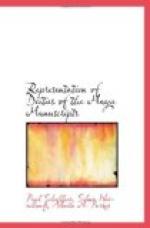These astronomical surmises seem to be contradicted by the fact that god C, as already stated, is represented with all the four cardinal points (compare for example Cort. 10 and 11, bottom), which would certainly seem to harmonize ill with his personification of the north star, unless we assume, that in a different conception of the polar star he is ruler of the cardinal points, which are determined from him as a centre.
It has already been remarked of B, that the deity C appears to stand in some sort of relation to him. In fact, we find on those pages of the Dresden manuscript, where B is represented with the four cardinal points, that the hieroglyph of C almost always occurs in the text also (for example Dr. 29, et seq., especially Dr. 32c). Indeed, C’s hieroglyph is connected even with the signs of the symbolic colors of the cardinal points, already mentioned in connection with B.
Finally, it should be borne in mind, that god C also seems to be connected in some way with the serpent (compare Dr. 36b, 1st and 3d pictures).
According to Foerstemann, the day ruled by C seems to be Chuen.
D. The Moon- and Night-God.
[Illustration: Figs. 17-20]
This is a deity who is pictured in the form of an old man with an aged face and sunken, toothless mouth. He is frequently characterized by a long, pendent head ornament, in which is the sign Akbal, darkness, night, which also appears in his hieroglyph before the forehead of the deity, surrounded by dots as an indication of the starry sky. His name-hieroglyph is Fig. 17, and a second sign almost always follows (Fig. 18) which evidently serves likewise as a designation of the god, just as god A also is always designated by two hieroglyphs. The second sign consists of two sacrificial knives and the sign of the day Ahau, which is equivalent to “king”.
The head of this deity appears in reduced, cursive form as the sign of the moon (Fig. 20). This character also has the significance of 20 as a number sign in the calendar. The association of these ideas probably rests upon the ancient conceptions, according to which the moon appearing, waxing, waning and again disappearing, was compared to man, and man in primeval ages was the most primitive calculating machine, being equivalent, from the sum of his fingers and toes, to the number 20. Twenty days is also the duration of that period during which the moon (aside from the new moon) is really alive. Moreover the sign (Fig. 20) appears in many places as a counterpart of the sign for the sun.
God D occurs once as feminine in the same passage mentioned above, in which the death-deity is also pictured as feminine (Dr. 9c). In a few other places the god is, curiously enough, depicted with a short beard, as Dr. 4c, 7a, 27b. He seems to stand in an unknown relation to the water-goddess I (see this deity) with the serpent as a head ornament, compare Dr. 9c, where apparently this goddess is represented, though the text has D’s sign; still it is possible that god D is pictured here with the attributes of goddess I.




